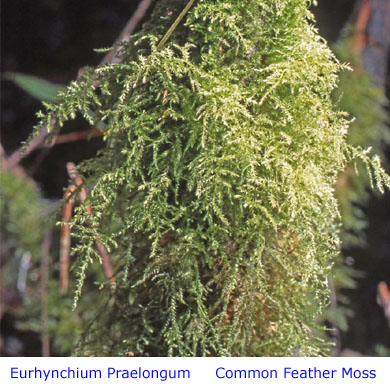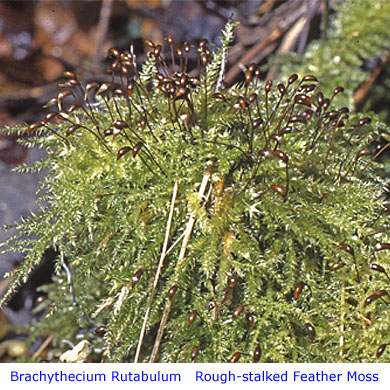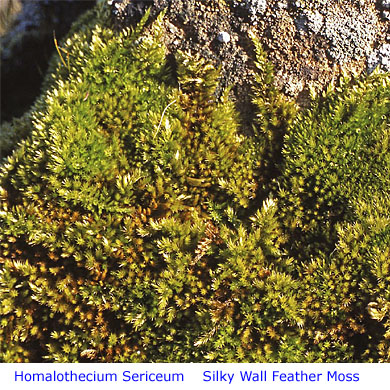|
Mosses and Liverworts recorded in Blisworth Churchyard Rachel Carter - 2008 It turns out that the Churchyard around
St. John the Baptist Church, Blisworth A few local enthusiasts study mosses and liverworts, ie. Bryophytes, both for their own interest and enjoyment, and to gather data for mapping projects coordinated by the British Bryological Society. Mosses and liverworts are best appreciated by looking at them very closely, with a hand lens or a microscope; if you want to do this, choose one which is obviously very plentiful, and even then only take a small piece. The website www.britishbryologicalsociety.org.uk is good for more information; go to Activities, "BBS Field Guide - main site" for an index to get to pictures and descriptions. In a county like Northamptonshire with little open
countryside, churchyards can be an important habitat for all kinds of
wildlife and mosses are no exception.
Species which like to live on stone do particularly well, but
there is often a good variety of soil- and tree-loving ones as well
although Blisworth lacks the latter.
Liverworts tend to need higher moisture levels than mosses so
they are relatively less frequent in churchyards. A
fairly ordinary
churchyard in Northamptonshire would typically support fifteen or so
varieties, richer ones about 20 or 30 and the best, including Blisworth,
more like 30 or 40. Blisworth churchyard has a good range of fairly
common mosses, plus two which are comparatively rare locally.
Hygrohypnum luridum
usually grows in wet places, on stones by or in streams etc, but it does
occasionally turn up on wet stone in churchyards and
8 of the 10 recent records of this species in Northamptonshire are from
this sort of habitat - the others being a woodland stream and a
canal. Syntrichia
virescens is a small moss which grows in hairy cushions on trees and
stones; there are about 20 records of it in Northamptonshire, but it may
be under-recorded – you need a microscope to distinguish it from other
rather similar hairy cushions. |
|||
|
Species |
English
name |
Notes |
|
|
Amblystegium
serpens |
Creeping
Feather-moss |
Tiny,
thread-like shoots in a fine mat; fairly common |
|
|
Barbula
convoluta |
Lesser
Bird's-claw Beard-moss |
On
bare soil; often makes a yellowish-green patch |
|
|
Barbula
unguiculata |
Bird's-claw
Beard-moss |
On
bare soil; common in gardens |
|
|
Brachythecium
rutabulum |
Very
common moss, creeping in big green patches on soil, stone or wood |
||
|
Bryoerythrophyllum
recurvirostrum |
Red
Beard-moss |
Small
moss with narrow leaves; often brick-red low down |
|
|
Bryum
argenteum |
Silver-moss |
Tiny
silver shoots; often grows on pavements |
|
|
Bryum
capillare |
Capillary
Thread-moss |
Common
on walls, also on wood; spirals up when dry |
|
|
Bryum
dichotomum |
Bicoloured
Bryum |
On
bare soil; often has baby plants in the leaf axils |
|
|
Bryum
rubens |
Crimson-tuber
Thread-moss |
On
bare soil; often has tiny red football-like “tubers” |
|
|
Calliergonella
cuspidata |
Pointed
Spear-moss |
In
grass, damp areas. Shoots almost sharp at tip |
|
|
Ceratodon
purpureus |
Redshank |
Common
moss of acid soils, can look reddish en masse – but here it is a green
and non-descript cushion |
|
|
Didymodon
insulanus |
Cylindric
Beard-moss |
Narrow
leaves, top ones longer than lower; twisted when dry |
|
|
Didymodon
luridus |
Dusky
Beard-moss |
Small
moss growing on stone;
leaves more triangular than the other Didymodons |
|
|
Didymodon
nicholsonii |
Nicholson's
Beard-moss |
Small
plant with narrow leaves growing on the tarmac path.
Formerly rare, but recently spreading widely |
|
|
Didymodon
rigidulus |
Rigid
Beard-moss |
Small
plant with blunt-tipped narrow leaves |
|
|
Didymodon
sinuosus |
Wavy
Beard-moss |
Dull
green patches on damp graves. Leaves
have wavy edges and are often broken at the tip. |
|
|
Eurhynchium
praelongum |
Very
common, regularly pinnate shoots |
||
|
Fissidens
taxifolius |
Common
Pocket-moss |
On
bare soil. Flat shoots,
leaves in 2 rows [unusual in mosses] |
|
|
Grimmia
pulvinata |
Grey-cushioned
Grimmia |
Hairy
cushions with drooping capsules, on stone |
|
|
Homalothecium
sericeum |
Big
patches on graves and wall; curly-looking when dry. |
||
|
Hygrohypnum
luridum |
Drab
Brook-moss |
Uncommon
aquatic moss; copious quantities in the deep gully round church, NE side |
|
|
Hypnum
cupressiforme |
Cypress-leaved
Plait-moss |
Very.
common, especially on trees; here on wooden seat. |
|
|
Hypnum
lacunosum |
Great
Plait-moss |
Similar,
but swollen brownish shoots; on flat grave |
|
|
Lophocolea
bidentata |
Bifid
Crestwort |
Liverwort.
Notched leaves in 2 rows. In
grass, NE of church |
|
|
Plagiomnium
undulatum |
Hart's-tongue
Thyme-moss |
Big,
tall moss; long undulate leaves with teeth all round |
|
|
Rhynchostegiella
tenella |
Tender
Feather-moss |
Small
creeping moss with long narrow leaves; in gully |
|
|
Rhynchostegium
confertum |
Clustered
Feather-moss |
Common,
but rather non-descript, creeping moss |
|
|
Rhytidiadelphus
squarrosus |
Springy
Turf-moss |
Starry
appearance, in grass; common “weed” of lawns |
|
|
Scleropodium
purum |
Neat
Feather-moss |
Swollen-looking
shoots in grass by front gate |
|
|
Syntrichia
intermedia |
Intermediate
Screw-moss |
Large
hairy cushions on gravestones |
|
|
Syntrichia
virescens |
Lesser
Screw-moss |
Uncommon
moss, small hairy cushion on a gravestone |
|
|
Thuidium
tamariscinum |
Common
Tamarisk-moss |
Pretty
fern-like shoots, in the grass [often a woodland plant] |
|
|
Tortula
acaulon |
Cuspidate
Earth-moss |
On
bare soil; large round capsules buried in leaves |
|
|
Tortula
muralis |
Small
hairy patches on walls and gravestones; very common |
||
|
Zygodon
viridissimus |
Green
Yoke-moss |
Small
plants on the church wall [more often grows on trees]. |
|
|
Below are some photogenic mosses - photographs by Rachel Carter |
|||

|

|
||

|

|
||